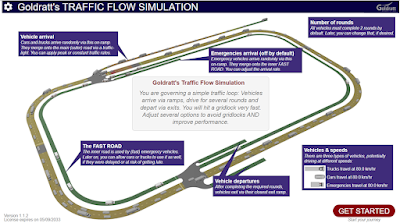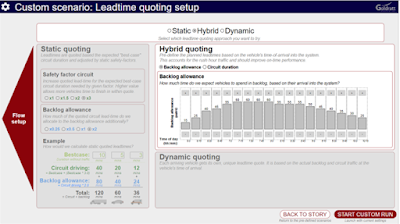Thanks to Dr. Alan Bernard for letting me test the Traffic Flow Simulator ver 1.2.2.
This simulator is ready to run after downloading. It is based on AnyLogic infrastructure. There are two lanes main road and a fast road. A vehicle arrival point which is driven by a traffic light and a vehicle departure point are provided. There are 3 types of vehicles selected by arrival rate and allowed speed. It is possible to imitate rush hours such as early in the morning and fluctuating traffic density in the simulator. The fast road could be interpreted as an emergency lane or a side way or a "paid lane".
The simulator is running very similar to the navigation application. There is a calculated travel time for the destination covering certain parametric allowances. The performance will be reported based on travel time. There are 3 different options for calculated travel time: Static has full allowances and the same for all vehicles, the hybrid has flexibility by the rush hours and the same for the vehicles in that particular hour, and finally dynamic is based on each vehicle and arrival time - traffic density, ie. different for each vehicle.
There is a very versatile and rich set of KPIs for reporting performance. Conventional traffic light color codes are applied for road segments, vehicles, and various result figures. The storyboard flow of the simulator is quite interesting and encouraging to learn.

I have tried an interesting and not implemented suggestion for a real road segment in Istanbul by official arrival rate figures. In this suggestion, smart traffic lights powered by three selected road segments around traffic lights and sensitive to real-time traffic density.
The initial state is reflected to the simulator and then the proposed smart traffic lights suggestion is applied. It amazingly increased throughput by 320% and decreased backlog before joining the main road by 75%.
I have thought of another point inspired by the simulator. It is a smart city version of the fast lane by letting prepaid selected vehicles by the central control tower to switch to the fast lane.
Dr. Alan Bernard has another nice reflection for the simulator. He is interpreting the simulator as a production environment. Now fast-moving small cars are ordinary job orders, slow-moving large trucks are time-consuming big projects and emergency vehicles are rush orders... The backlog means the orders have not been issued to the production floor yet, the capacity of the road is the capacity of the flow line, and the number of vehicles completing the track is the real throughput. The smart traffic lights concept is very similar to DBR (Drum Buffer Rope) mechanism.
Now you could try different scenarios to improve flow in your production unit!





Hiç yorum yok:
Yorum Gönder